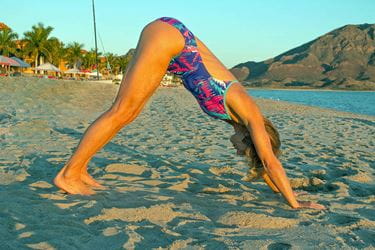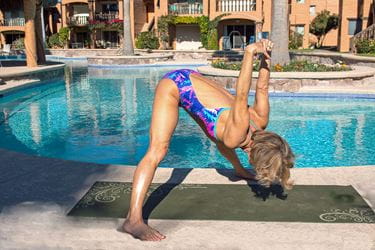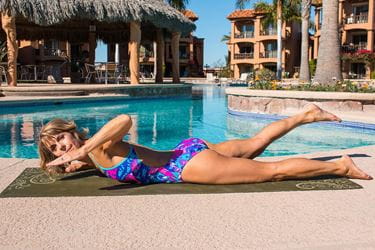Three Yoga Poses to Relieve Discomfort in Your Neck and Shoulders
Hours in front of a computer can hurt your body
Multiple swims at a major competition, hours spent watching television, or overtime in front of a computer can leave your neck and shoulders crying for relief. These three yoga poses, or asanas, downward-facing dog, feet-spread-intense-stretch posture, and the back lift work in different ways to soothe neck and shoulder discomfort.
For best results, perform these asanas after a series of sun salutations or a bout of aerobic activity when muscles are warm and more flexible. The “no pain, no gain” philosophy should be discarded when practicing yoga. Muscle lengthening and a burn in the working muscles is normal, but you shouldn’t feel pain in your spine or joints.
For the first two asanas, move into a comfortable expression of the pose and then remain there for five to 10 slow breaths. Follow the specific instructions for the back lift, which is a somatic movement activity and performed differently than the other two.
Breath, or pranayama, is the most vital component of yoga and should always lead the way when moving into and sustaining a posture. Breathe long and slow and smooth, feeling expansion in your abdomen, rib cage, and chest. Notice the subtleties of the breath. Taking deep breaths will help you become more aware of breath quality and how proper alignment enables you to take longer, more restorative breaths.
Downward-Facing Dog (Adho Mukha Svanasana)
Benefits
A hunched posture makes it difficult to do overhead movements without creating undue compressive forces inside the shoulder. This can lead to impingement and tendinitis.
The downward-facing dog relieves shoulder and neck pain by opening the spaces in the cervical vertebrae and stretching overtight muscles that contribute to poor posture and might eventually cause discomfort. Doing this pose on a regular basis will improve range of motion in the shoulder and enhance flexibility of the latissimus dorsi muscles (side-body muscles that attach to the ribs and fascia of the lower spine all the way up to the arms), pectoralis minor, rhomboids, posterior deltoids, and teres major, improving your upper postural alignment and streamline position.
The weight-bearing action of downward-facing dog also strengthens muscles in or around the spine and shoulder girdle. The shoulder joint needs a proper balance of strength to keep the head of the humerus (upper arm bone) properly aligned in the glenohumeral joint socket. Strong shoulder girdle muscles can help improve shoulder stability and function, enabling a swimmer to increase stroke tempo or distance with less potential for injury.
How to Execute
An easy way to transition to the downward-facing dog is to hinge (bend) forward at your waist, bending your knees enough that your hands can touch the mat. Walk your feet away from your hands until they are a few feet apart and raise your sit bones skyward. Your hands should be positioned shoulder-width apart with your fingers spread and your feet should be positioned about hip-width apart.
Gently start to press your chest back toward your thighs and your heels toward the floor, keeping your hips high and your neck relaxed (so the crown of your head and the back of your neck feel like they’re in alignment with the rest of your spine and are lengthening toward the floor). Avoid locking your elbows and knees. Instead, bear your weight in the supporting muscles. This is good time to very slowly nod “yes” and shake your head “no.” This will help relax any tension you’re holding in your neck.
To avoid possible impingement, it’s important to externally rotate your shoulders. Swimmers with wrist problems can modify this pose by supporting themselves on their forearms rather than their hands. This modified pose is known as the dolphin.
Feet-Spread-Intense-Stretch Posture (Prasarita Paddotanasana C)
Benefits
The feet-spread-intense-stretch posture, one of the easiest inversion poses to execute, stretches your hamstrings, inner thighs, pectorals, and fronts of your shoulders. This is a great posture to do after a race or a hard swim workout. The pectoral and shoulder stretch will loosen muscles and restore balance to your posture. The inversion will help relax your neck.
posture to do after a race or a hard swim workout. The pectoral and shoulder stretch will loosen muscles and restore balance to your posture. The inversion will help relax your neck.
How to Execute
Stand facing one of the long sides of your mat. Walk your feet out into a wide stance until you feel a comfortable stretch in your inner thigh muscles. Turn your toes forward. Interlace your fingers behind your back and open the sides of your shoulders by squeezing your shoulder blades together. Take a deep inhale and as you exhale slowly hinge at your hips, tipping your torso and clasped arms forward, lengthening through your spine. Think about opening your chest and lengthening from the sacrum to the crown of your head as you tip forward. You can gently nod or shake your head to loosen your neck muscles more. Avoid hunching in your upper back or dropping your head forward. Keep your legs active to create a balanced foundation for the pose. Distribute your weight evenly across the bottom of your feet and avoid gripping with your toes. If you feel discomfort in the backs of your knees, bend them slightly.
Back Lift
Benefits
People who train at a high level can experience sensory motor amnesia, a state where muscles become habitually tense and shortened. This can lead to chronic pain or injury.
Somatic movements can retrain your muscles and brain to achieve a relaxed state post-race and post-workout. The back lift is a somatic movement that engages the brain and nervous system to release unconscious patterns of tension in your neck and shoulder muscles, common problem areas for swimmers. The back lift will help you regain control of neck and shoulder muscles that are contracted, whether involuntarily or chronically.
How to Execute
There are two steps to this exercise. Try the simple one first and then progress to the more complex one. Notice the sensations you’re experiencing in your body. Do the movements slowly to enable your brain to fully process what’s happening.
For the first exercise, lie on your belly with your head turned to the right side, left cheek on the mat. Slowly raise your head and part of your upper torso and turn your head toward the left before relaxing down with the right cheek on the mat. Feel your back muscles contract each time you lift. Notice your back muscles and neck muscles contracting during the lift and releasing on the way down. Pause for a breath to completely relax before raising your head and turning it toward the other side. Remember, it's the slow release and pause to rest where the muscles reset. The relaxation phase is critical. Continue to lift and turn your head until you have turned your head to each side four times.
Once you finish, place your forehead on your mat, forearms, or a folded towel, and just allow your body to rest and relax. Visualize your neck and upper back muscles softening and melting down toward the ground.
For the second exercise, begin on your belly with your head turned to the right, left cheek on your mat. Inhale and slowly raise your left leg, no more than 3 inches off your mat so you don’t create pinching in your lower back. Lift your head and your upper torso, as well as your right arm with the palm facing down and your fingertips near your face. Your elbow should be raised slightly higher than your hand, similar to freestyle recovery. You should feel a diagonal contraction along the back of your body. Slowly and smoothly lower back down to the floor and relax. Rest for a moment and repeat two to three times. Transition to the other side and do the same activity with your head turned to the left, right leg raised. Finish by resting your forehead in a position you found comfortable during the first exercise and allow your body to completely relax and sink downward.
Categories:
- Technique and Training
SIGN UP FOR UPDATES FROM USMS
















